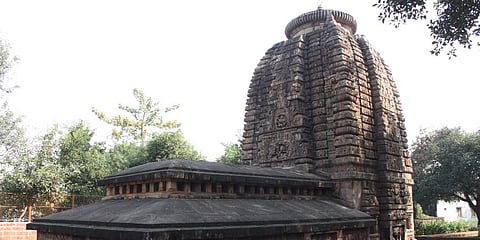

Bhubaneswar emerged upon the political scene of modern India only in 1949, when it took over as the capital of the state of Orissa (now Odisha) from Cuttack. The new capital was developed around the old Bhubaneswar town, and designed by the German architect Otto Konigsberger. The old town of Bhubaneswar showcases an illustrious and unbroken heritage of more than 2,500 years, exhibited by its magnificent monuments and temples.
Religious texts and literature refer to Bhubaneswar as Ekamra, named so because of a sacred mango tree at the site. It is said that when Shiva retired from Varanasi in Treta Yuga, he took abode at Bhubaneswar. Historian Rajendralal Mitra says that nothing was omitted in the way of detail to make Bhubaneswar the exact counterpart of its prototype (Varanasi). Every temple, every sacred pool, every rivulet, every ceremonial, every observance and every legend of Varanasi were reproduced at Bhubaneswar. Brahma Purana tells us that Ekamra Kshetra is dedicated to Lord Krittivasa (Shiva) and equals Varanasi in merit.
Tangible antiquity of the town can be traced back to the 3rd-4th century BCE, to Sisupalgarh. Excavations at the site have revealed a well-planned, fortified and densely populated town. The next episode of importance is found in the famous war between the state of Kalinga and Ashoka Maurya. The Kalinga war can be historically placed around 261 BCE. Two edicts of Ashoka are found in Odisha, one at Dhauli and another at Jaugada. Dhauli hill is about 10 km from Bhubaneswar. A rock-cut elephant of the Maurya period, carved near the edict and shown emerging from the rock, probably represents the advent of Buddhism in Kalinga after Ashoka’s conquest. A majestic white Shanti Stupa, built on top of the Dhauli hill in 1971-72, keeps Buddhism reverberating in the environs.
King Kharavela was ruling over Kalinga during the 1st century BCE and being a follower of Jainism, he excavated various cave shrines and shelters in the hills of Udayagiri and Khandagiri. Various narrative panels over Rani-gumpha, Manchapuri and Svargapuri-gumpha, and Ganesha-gumpha on the Udayagiri hills are excellent representatives of the elegant and graceful art movement of that period. A long inscription of King Kharavela on the Udayagiri hills provides his curriculum-vitae and the supremacy he enjoyed. While Udayagiri witnessed a decline after the 11th century CE, Khandagiri has kept its status as a Jain pilgrimage centre till today.
With the advent of the Sailodbhava dynasty in the 6th century CE, Hinduism received the much-required impetus from the royal house. Various temples, all dedicated to Shiva, were constructed during that time. This set the foundation for Kalinga temple architecture, the culmination of which we see later in the famous Lingaraja temple. While the earliest Hindu temples in Bhubaneswar are the ones in the Shatrughneswara temple complex, dated around 575 CE, the best specimen of the Sailodbhava period is the Parasuramesvara temple, embellished with exquisite sculptures all around its external walls. The presence of Lakulisa in temple sculptures of this period suggests the influence of this sect over the religious settings.
The Bhauma-karas succeeded the Sailodbhavas during the 8th century CE. Their early kings being the followers of Buddhism, that religion’s activities regained the missing royal patronage. But Hindu temple construction activities continued during their rule. A few important monuments of this period are the Mohini, Markandesvara and Sisiresvara temples. The crown jewel of the Bhauma-karas is the Vaital Deul, a very important shrine associated with Tantric and Shakta practices of that period.
The Bhauma-karas were succeeded by the Somavamshis and this begins the golden period of Bhubaneswar with the town getting its due importance on the religious circuit of India. The epitome of their times is the Lingaraja temple, which dominates the town with its 55 metre-high tower. A few other notable ones are the Mukteshvara, Rajarani and Brahmeswara temples. The torana-gateway of the Mukteshvara temple is the most photographed monument in Bhubaneswar.
The 11th century CE finds the Eastern Ganga dynasty succeeding the Somavamshis. While the Eastern Ganga kings are famous for their Puri and Konark Sun Temples, Bhubaneswar too witnessed tremendous growth during this period. The most famous temple of this dynasty is the Ananta-Vasudeva temple. Among other notable ones are the Chitrakarni, Megheswar, Rameshvara, Bhaskareshvara and Bakreshvara temples.
The Eastern Gangas were succeeded by the Gajapatis in the 15th century CE. Very few new temples were erected during their rule, the most notable being the Kapileswar temple. After the fall of the Gajapatis in the mid-16th century CE, Orissa soon became part of the growing Mughal empire in 1576 CE. While Bhubaneswar continues to enjoy its religious position, however the centre of activities soon shifted to Puri; the latter became the epicentre of religious supremacy and tutelary deity of local Hindu rulers.
In its chequered history in the last 2,500 years, Bhubaneswar has embraced and provided a conducive environment for the growth of all religions: Hinduism, Buddhism and Jainism. Its religious centres are still active and frequented by pilgrims and tourists alike.
Saurabh Saxena
Founder of Puratattva, a documentation of heritage sites
(Puratattva.India@gmail.com)